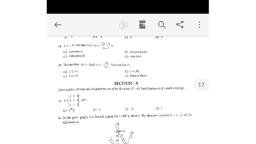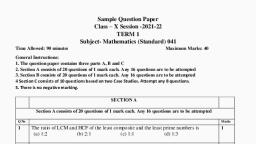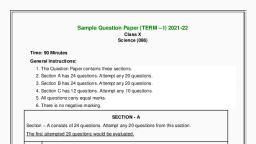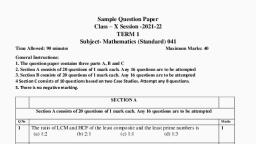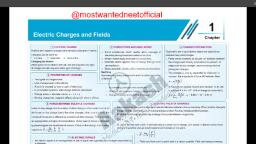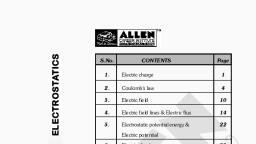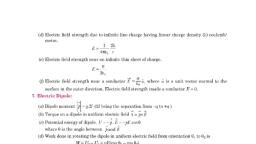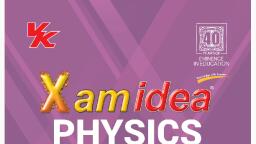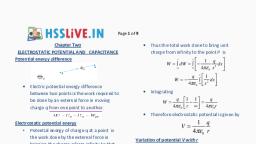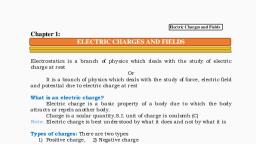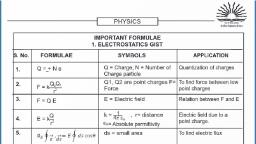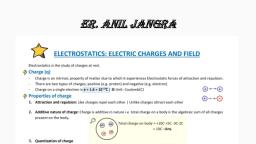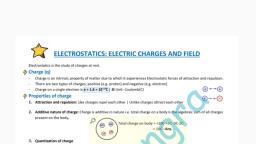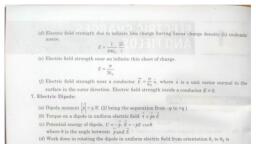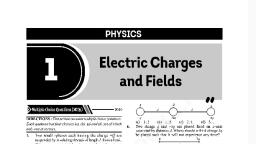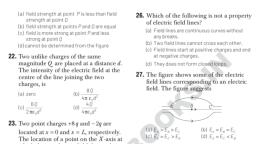Page 1 :
LP = : a XX, ; {> ( INE ‘ v), The study, of Glectric Charge? at rest is called Electro, , ars Statics., , , , , , , J a hie . - ‘ om — = ;, er Wwo Kinds of Electric Charpes ee Ts, —>When two bodies are] rubbe}t together, they getloppositely chatghe: papetimental evidences show, Fr : ., that there are two sof charges: hence, , , , , , , , , , , , , , , (i) Positive Ch, , a, , arge: Positive charge is prod, That is, [positive charge means dleficienc, ae . _——, , (t#) Negative Charge: Negative char, , negative char nf Means] exce, , from a neutral body., , , , , a neutral body. That is,, , apn, , ated system remains constant. This means that, charge can neither be creatéd nor destroyed. but it may simply be transferred from one bod, , maa Conservation of Charge: The charge of an iso], <a Seon royed ’, , to another., , (iy Additive Property: Total charge.on an isolated system is equal to the algebraic sum-ef charges, on individual bodies of System. This is called |, , additive propertyc ges. Ifa system cgntains, snree charges, Hs Ip - dashen total charge on system, QL445.q0-05 ts ke do N\ ‘, _Aly)-Quantisation of Charie: 1€ total charge on_a bod, , , , , , , , p iS“intesral multiple of fundam tal, charge‘e’ ee a, Lb, lg = tne. | where n is an integer (n = 1, 2, Bysc),, ie ge is unalfected by motion: The charge_on_a-badsy- AMains unaffected of its velocity, i.e.,, a8 | Charge at rest = Charge in motion, , wtof Like charges repel while unlike charges attract each other., om, , b’s Law in General Form ; ., , t states that the force of attraction or repulsion between two oint charges is direct] roportional, to the product of magnitude of charges and inversel, , Ds Oe ——S<Y proportional to the square of distance, between them. The direction of this force is along the- € joining the two charges, 7.¢.,, , -. —, , , , , , , , F =p, h, , — Y, , , , , , , where} = —— }s constant of proportionality; ¢ is permittivity of medium between the charges. If, , , €£)1S permittivity of free space and K the|dielectric constant of medium, the e=Ke, |, he
Page 2 :
re, , , , , , , , , , Ol, for 41, For free space K = 1, Theretore, " is defined as, Stitt ; ielectri |, Dielectric constant or Relative permittivity By oe ve fee spate, be K = eley |, a : ermittivl , |, the ratio. of permitsiity aie ‘ch when placed ata distance of metre, ——Fcoulon lomb charge is the charge which WAT 9 x 10°N., Definition of coulomb: | coulo 2 pcan it with a force O, from an equal and similar charge 1n vacuum (Or air) Wl P ,, lomb’s Law in Vector Form ‘on bet, * ce ; located at points A and B in vacuum. The separation Detween, Consider two like charges q, and qg locate p ree wzerted on charge, | . . Fo; be the tor |, the charges is r. As charges are like, they repel each other. Let Fal re | ail, + y by charge qo: If ro, is the position vector Of q,, qo by charge q; and Fig that exerted on charge q; Dy ge Jo 1, a . ce Fo i ng Ato Ban, relative to q, and 7, 1s unit vector along A to B, then the force Fe: is along, | , | 6. C, = _ 1 fit. (2) 7, Hai = 4n€, 2 | 2! 7, 2 a FE,, But = A BY! |, > —_—__Oot—- ——»O——, nat ATE, r? op aE ANE, r ale . _$—— Ir ————_ | i, , Similarly if 719 is position vector of q, relative to q. and 719 is unit vector from B to A, then, , — 1 %% 1 > © z:, 12 = ANE, 2 Tio = ane, 73 roi : (12) NE, , , , , , - Obviously 119 = -— 7, therefore equation (i) becomes . - ", f | i, , ¢.-_1 42> mo d x), 12 4m, 7? ral ; (iit) | u, Comparing (2) and (2), we get oe : 3) :, ~ + U, Fo) =-F 19 | é Sy, This means that the Coulomb’s force exerted on qo b oe, , , 9 Dy q; 18 equal and opposite to the C ;, , force exerted on q, by go; in-accordance with Newton’s third law. rp owen, Thus, Newton’s third law also holds good for electrical forces. 4, 5. Principle of Superposition of Electric Charges f, |, , Coulomb's law gives the force between two point charges, charges, then the force on a particular charg, states that, , , , , , Suppose that a system of charges contains n charges, 4, , ... g, having position vectors Wy» Mop Typ
Page 3 :
harges is to be found. If EF Fo, Fs, ., quan ow’ the net force on q 1s, , du sie, one , respectively, then by the principle of superposition,, , Q» 929 93, °° 1, , F= Fi, + Fo t+ F3 +... + Fy, , , , ‘ ctor form, If the force exerted due to charge q; on gq is F;, then from Coulomb’s law 1n ve, , i > - ore, tre | ane |7 7, [2, , The total force on q due to all n charges may be expressed as, | s l qq; > >, , , , , , , , Here 2 represents the vector-sum., rector Sm,, , ) 6. Continuous Charge Distribution, , , , The electrostatic force due to a charge element dq at charge qo situated at point P 1s, , ] Io@q — l Gold > =, , R= ——.—.~(r -1r), AME, R? ANE 3, , , , , , , , >, d¥ = a, ol|r-r |, , The total force on gp by the charged body is, , dq(r -r’), , ], i q) = ST, 4ne, *° lr-r |? |, , | !) For linear charge distribution, |dq = i dl,])where A is charge per Y, , unit length and integration is over the whole length of charge., x) For surface charge distribution, dg = ods| where o is charge per, , unit area and integration is for the whole surface of charge. ., , 3) For volume charge distribution, Mg =pd vy jwhere p is charge per, , unit volume and integration is for whole volume of.charge., , og Electric field |, 5 The electric field strength at any point in an electric field is a vector, , quantity whose magnitude is equal to the force acting on per unit ©, ositive test charge and the direction is along the direction of force., , , , , , , , , , If F is the force acting on infinitesimal positive test charge g, then electric field strength, \ >, , Therefore from definition, electric field can be given as, , , , , , , , , E = lim +, I~ 94, 7"-—-, The unit of electric field strength is newton/coulomb or, , (abbreviated as N/C or V/m respectively.) volt/metre, , () The electric field strength due to a point charge :, magnitude form ata Paka distance r in, , . 7m,, , , , ri,, Fy, t, et, ‘i
Page 4 :
Lt a |, , In vector form, E= 4TE, r, , (2 ) tric field streng ., , ° ° e iS, continuous charge distribution, , (iii) The electric field strength due to a (YN |, , 4nE,° ae, °, hei field lines yee apaaht 1 tome which an isolated free, e e e ° ® |, , The klectric field line\in an electric field is an\ymagt a | en, Ws: wer, , ‘tive test charge tends to.move., —— : h is defined as follo, _———oOe, , In terms of electric field lines the electric field strengt, , E lectric field strength ht any point ts defined as a vector _ . a, ic_fie es :, hose magnitude _is = : : ae 8, nit small area around that point at —\, , whose direction is along the tangent on field line drawn on that, , , , , , , , passing normally through per u, , oint. | >, , _pornt. — . e, Accordingly nearer the electric field lines, stronger is the electric field, and farther the electric field, , a, , lines, weaker is the electric field. In figure, the electric field strength at A 1s greater than that at B. |, , sgt _eere, © Properties of electric field lines |, , (i) Fhe electric field lines app@&, , charge, E, , (ii) The tangent drawn at any. point on the field line gives the direction of electric field strength at, that point and the direction of force acting on a positive charge at that point. |, , , , , , , to start from positive charge and to terminate at negative |, , Nw (ii) No two electric field lines can intersect each other because if they do so, then two tangents can, : : SE 5 : “ .. « 7 . 7" : SS, — be drawn at the point of intersection; which would mean two directions of electric field strength, ne ip ie TITEL, , at one point and that is impossible. | |, , , , , , , , , , , , 7 The reason is that opposite charges attract, C) and similar ., , , , , (a) Uniform electric b) Non-unif, DW fhe clei tdlines do noe form any dosed 7 seta, oops. ¥ | |, (vi) The equidistiar ele ic field ]j ie, , differe, , , , , cparations ~cpresent non-uniform electric field (Figure), , , , represent uniform electric field wh;, t uniform hile electric field lines at |, , (wv) The electric field lines have _a tendency to ‘, contract lengthwise like a stretched elastic * |, string and separate from each other laterally. a | | ——— ee Z, Scecs, , , , , , ining |two equal and ., — electric dipole, Dipole Evo equal and oppotits charges separated by a Ke, , nt of electr finite distance is called an, as the product of magnitude of one SF th 'po’e having charges tq and ~¢ at separation 2/ is defined, , 7 => > —_—_____oO; A. Ap = 9.21Vy, , ef, WN" 7 It is a vector quantit ‘(directed from, , , , [R k: Net ch qto+q |, emark: Net Charge on ane Cle, , ro, , a, , pase o tum A bend, , ¢, , , , 13.

